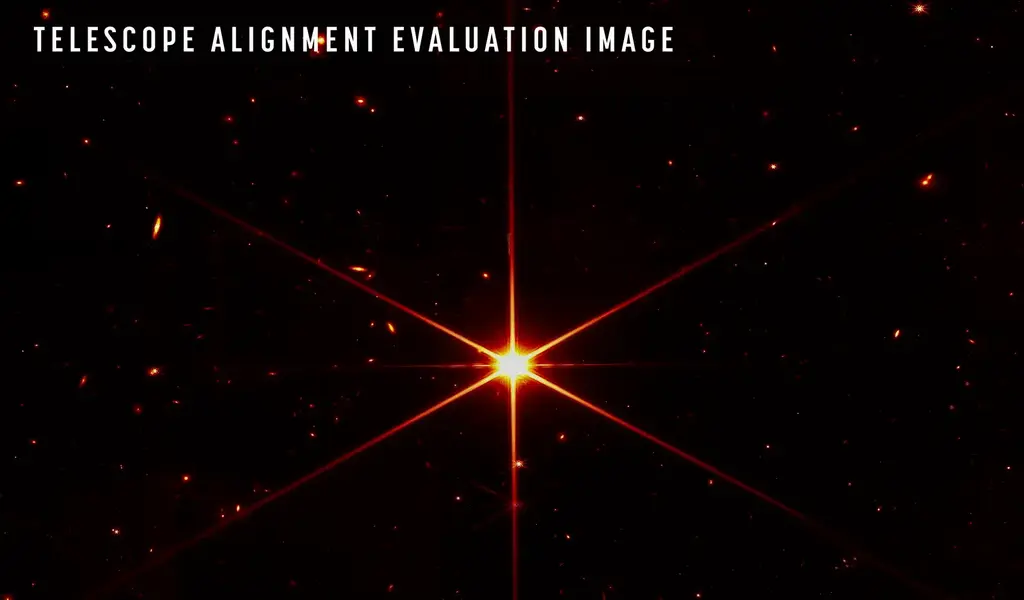NASA Says the Webb Space Telescope will perform as Expected

The primary imager of the Webb Space Telescope has been aligned by mission controllers, a critical milestone in the observatory’s commissioning phase.
Let’s take a moment to admire the new Webb image before getting into the details of today’s announcement. Webb Space Telescope mission controllers have used the star to align the telescope’s 18 hexagonal mirrors. It is known as 2MASS J17554042+6551277. However, take a look at how sharp it is. It’s amazing how many galaxies are in the background. Even though it’s just a “test” image, it’s unreal.
NASA project scientist Jane Rigby says “this is the future from now on – everything we see will be in the deep field,” at today’s press conference. She explained that we could only sharpen this image by making a bigger mirror.
At the meeting, Rigby and her colleagues discussed the end of the fine phasing stage on March 11. As a result, the primary imager of the Webb Space Telescope, the Near-Infrared Camera, has been aligned fully, and all 18 segments work together as one to observe the cosmos. A further round of alignments is needed, including work with the near-infrared spectrograph, the mid-infrared instrument, the near-infrared imager, and the slitless spectrometer, but Webb is already astonishing everyone with its performance.
Also Check: Tactile System: Do You Know What the Tactile System Is?

In mid-February, engineers brought 18 dots of starlight into a coherent pattern.Image: NASA/STScI/J. DePasquale
Thomas Zurbuchen, NASA’s associate administrator for science, said at the press conference that this has been one of his most magnificent days at the agency. “Today we can confirm that the optics will perform as expected if not better.”
The 21-foot 4-inch (6.5-meter) mirror of Webb had to be folded up and aligned to nanometer precision for launch. Webb still has a lot of work to do, including cooling the telescope, preparing the instruments, and completing the alignments, but the Webb Space Telescope is on schedule to begin its science phase by July. Upon completing the commissioning process, the science community will have access to the telescope and watch the infrared universe at a resolution they have never seen before, according to Zurbuchen. As the team nears the summit, “but the nights of sleeplessness are over.”
In the press conference, I asked the panel if there are still any critical failure points or if things can still go awry. The comments by Rigby echo those made by Zurbuchen, who noted that the heavy lifting has ended, and failure to perform will only lead to “partial degradation of science.” Rigby is still investigating the telescope’s temperature, as Webb continues to cool. Webb deputy telescope scientist Marshall Perrin added, “but the electrical systems are redundant and we’re in very good shape.”

This shot of Webb’s mirrors was captured using a specialized “pupil imaging lens” inside of the NIRCam instrument.Image: NASA
Optical performance of the telescope is astounding, Feinberg remarked and “is better than our most optimistic projections.” Webb’s launch illustrates that we’ve pioneered a new approach in building space telescopes and that it will prove to be very valuable to future generations. For Perrin, the biggest surprise was how closely Webb’s performance matched predictions. A Webb Space Telescope of this size is capable of focusing images as finely as the laws of physics allow, he said.
Rigby commented on the new Webb image by saying it was “picked from obscurity”, a “nice boring star with just the right amount of brightness.” The image has been captured in infrared and then processed with a red filter to achieve the maximum contrast. It is diffraction that causes the star to appear spiky.
As for Rigby, he said they’re on track to meet the mission’s “very demanding scientific requirements” but had refrained from collecting any science data. More than 1,000 proposals were submitted by astronomers requesting access to Webb, with only the “best ones” being chosen, and the first batch of targets has not been disclosed. At some point in the future, Webb will also study closer objects, such as the Trojan Asteroids and the moons of Jupiter and Saturn, a few million years after the Big Bang.
Also Check: Elon Musk asks Union to hold vote at Tesla factory in California
NASA, European Space Agency, and Canadian Space Agency will launch the $10 billion Webb space telescope on December 25, 2021. Following many years of delays, the Webb Space Telescope has now been launched into space, and it appears to be working beyond expectations. It will offer astronomers a new perspective for studying the oldest stars and galaxies, as well as the atmospheres of exoplanets in distant solar systems.






























